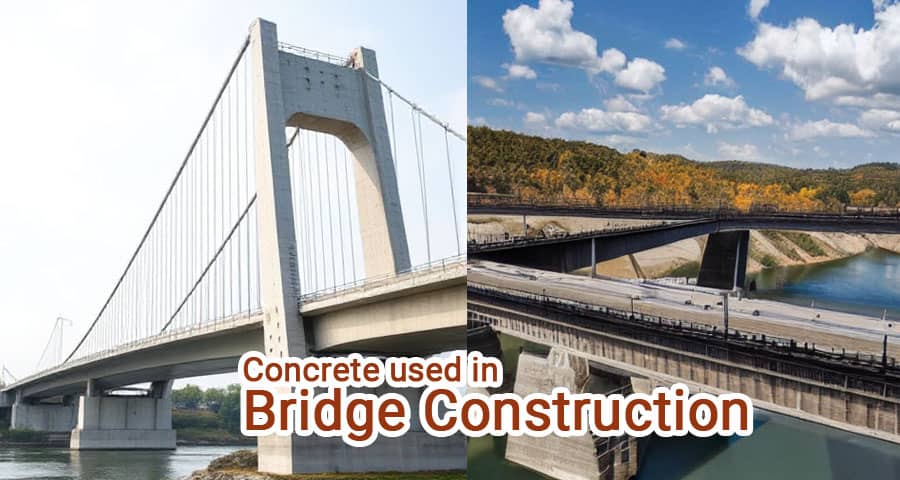Types of Concrete Used in Bridge Construction

Bridges are one of the most critical infrastructures in modern society, facilitating transportation and connectivity. The selection of concrete types for bridge construction is essential to ensure durability, strength, and longevity. Various types of concrete are employed based on environmental conditions, load-bearing requirements, and structural design.
1. Ordinary Portland Cement (OPC) Concrete
Ordinary Portland Cement (OPC) Concrete is the most widely used concrete type in bridge construction due to its versatility and availability. It is composed of cement, sand, aggregates, and water. This type of concrete is used for general bridge components such as piers, abutments, and deck slabs.
Advantages:
- High compressive strength
- Readily available and cost-effective
- Easy to mix and handle
Disadvantages:
- Susceptible to environmental degradation
- Prone to cracking under extreme conditions
2. Reinforced Concrete (RC)
Reinforced Concrete (RC) is a combination of concrete and reinforcement materials, usually steel bars (rebar), to improve tensile strength. It is extensively used in bridge decks, columns, and foundations where additional strength is required.
Advantages:
- High durability and load-bearing capacity
- Resistance to tensile and compressive stresses
- Long lifespan with proper maintenance
Disadvantages:
- Corrosion of reinforcement bars
- Requires skilled labor for construction
3. Pre-Stressed Concrete
Pre-Stressed Concrete is designed to counteract the tensile forces in a bridge structure, improving overall performance. This is achieved by pre-tensioning or post-tensioning high-strength steel tendons before applying the load.
Advantages:
- Increased strength and load capacity
- Reduced material usage, making it cost-effective
- Improved crack resistance and durability
Disadvantages:
- Requires specialized equipment and expertise
- Higher initial costs
4. High-Performance Concrete (HPC)
High-Performance Concrete (HPC) is an advanced form of concrete designed to provide superior durability, strength, and workability. It is commonly used in modern bridge construction projects requiring high strength-to-weight ratios.
Advantages:
- Enhanced durability and resistance to environmental factors
- High compressive strength
- Lower permeability, reducing water and chloride penetration
Disadvantages:
- Higher cost due to specialized materials
- Requires precise mix design and quality control
5. Self-Compacting Concrete (SCC)
Self-Compacting Concrete (SCC) is a type of highly flowable concrete that spreads into formwork without requiring vibration. It is widely used in bridge construction where complex reinforcement arrangements are present.
Advantages:
- Eliminates the need for mechanical vibration
- Reduces labor costs and construction time
- Improved surface finish and uniformity
Disadvantages:
- Requires careful mix design to maintain stability
- Higher material costs
6. Lightweight Concrete
Lightweight Concrete is produced using lightweight aggregates such as expanded clay, shale, or pumice. This type of concrete reduces the overall weight of bridge components, making it ideal for long-span bridges.
Advantages:
- Lower density reduces dead load on the structure
- Enhanced thermal insulation properties
- Improved fire resistance
Disadvantages:
- Lower compressive strength compared to normal-weight concrete
- Requires specialized aggregates, increasing costs
7. Fiber-Reinforced Concrete (FRC)
Fiber-Reinforced Concrete (FRC) incorporates fibers such as steel, glass, or synthetic fibers to improve tensile strength and crack resistance. It is commonly used in bridge decks and piers to enhance performance.
Advantages:
- Increased toughness and impact resistance
- Reduces shrinkage and cracking
- Improved durability in harsh conditions
Disadvantages:
- Higher cost due to fiber additives
- Requires precise mix proportions for optimal performance
8. Ultra-High-Performance Concrete (UHPC)
Ultra-High-Performance Concrete (UHPC) is an advanced concrete with exceptional compressive strength, durability, and ductility. It is used in critical bridge components such as precast girders and thin deck panels.
Advantages:
- Superior strength exceeding 150 MPa
- Exceptional durability and longevity
- Reduced maintenance costs
Disadvantages:
- High material costs
- Requires specialized production techniques
9. Shotcrete
Shotcrete is a type of concrete that is pneumatically projected onto surfaces at high velocity. It is commonly used for bridge repair, tunnel linings, and protective coatings.
Advantages:
- Rapid application and setting time
- Strong adhesion to existing structures
- Reduces construction time and labor costs
Disadvantages:
- Requires skilled application techniques
- Potential for material wastage
10. Polymer Concrete
Polymer Concrete is a type of concrete where polymers replace traditional cement binders. It offers enhanced chemical resistance and is used in bridge deck overlays and repair works.
Advantages:
- Excellent resistance to chemicals and weathering
- High bond strength with existing structures
- Reduced permeability and water absorption
Disadvantages:
- Higher cost due to polymer additives
- Requires specialized handling and curing
Conclusion
The selection of concrete types for bridge construction depends on various factors such as structural requirements, environmental conditions, and budget constraints. Engineers must carefully evaluate the advantages and disadvantages of each concrete type to ensure optimal bridge performance and longevity.
